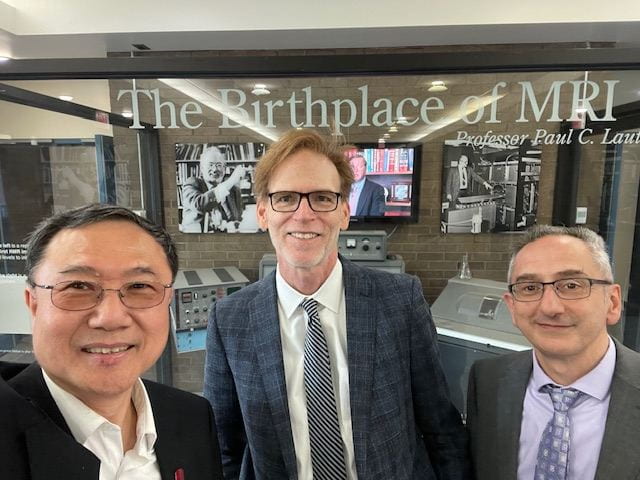BME NEWS
August 2024
Moore Publishes First Author Paper:
Christopher Moore of the Department of Biomedical Engineering published his second first author paper "A Device-on-Chip Solution for Real-Time Diffuse Correlation Spectroscopy Using FPGA" on biosensors, which is part of his work done for his undergraduate thesis project. Professors Wei Lin and Ulas Sunar co-mentored Christopher. This is the first reported study to integrate the electronic components of a diffuse correlation spectroscopy in one chip. Congratulations and best wishes to Christopher who is starting his MD/PhD program this year at the Renaissance School of Medicine.
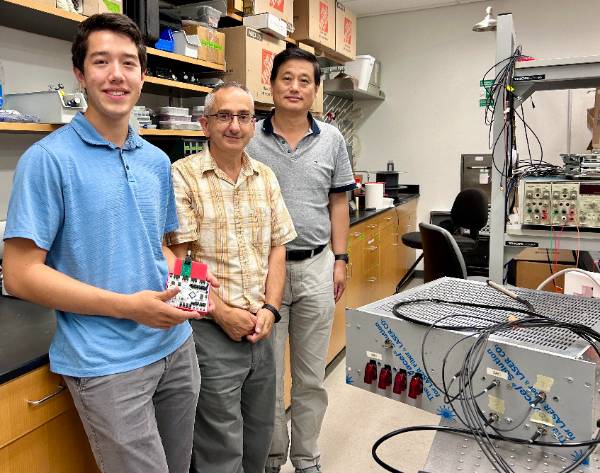
April 2024
Moore received 13 SBU Students Honored with SUNY Chancellor’s Award for Excellence:
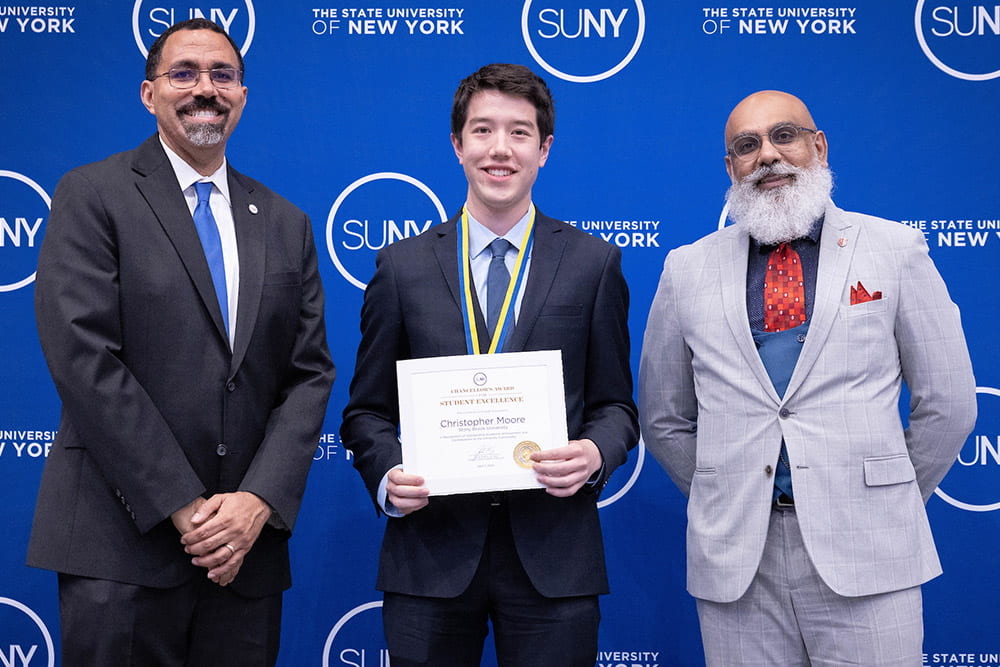
April 2024
Dr. Bruce Tromberg's Seminar
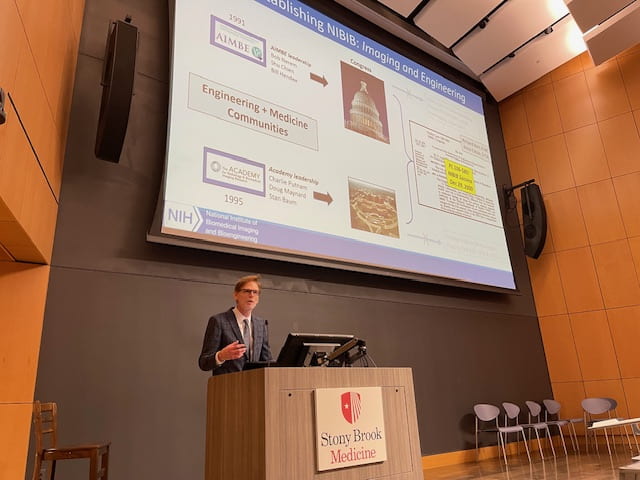
MAY 2023
Hooding Ceremony Highlights:
🎓🔬 Congratulations to the Biomedical Engineering graduates on your well-deserved hooding ceremony!
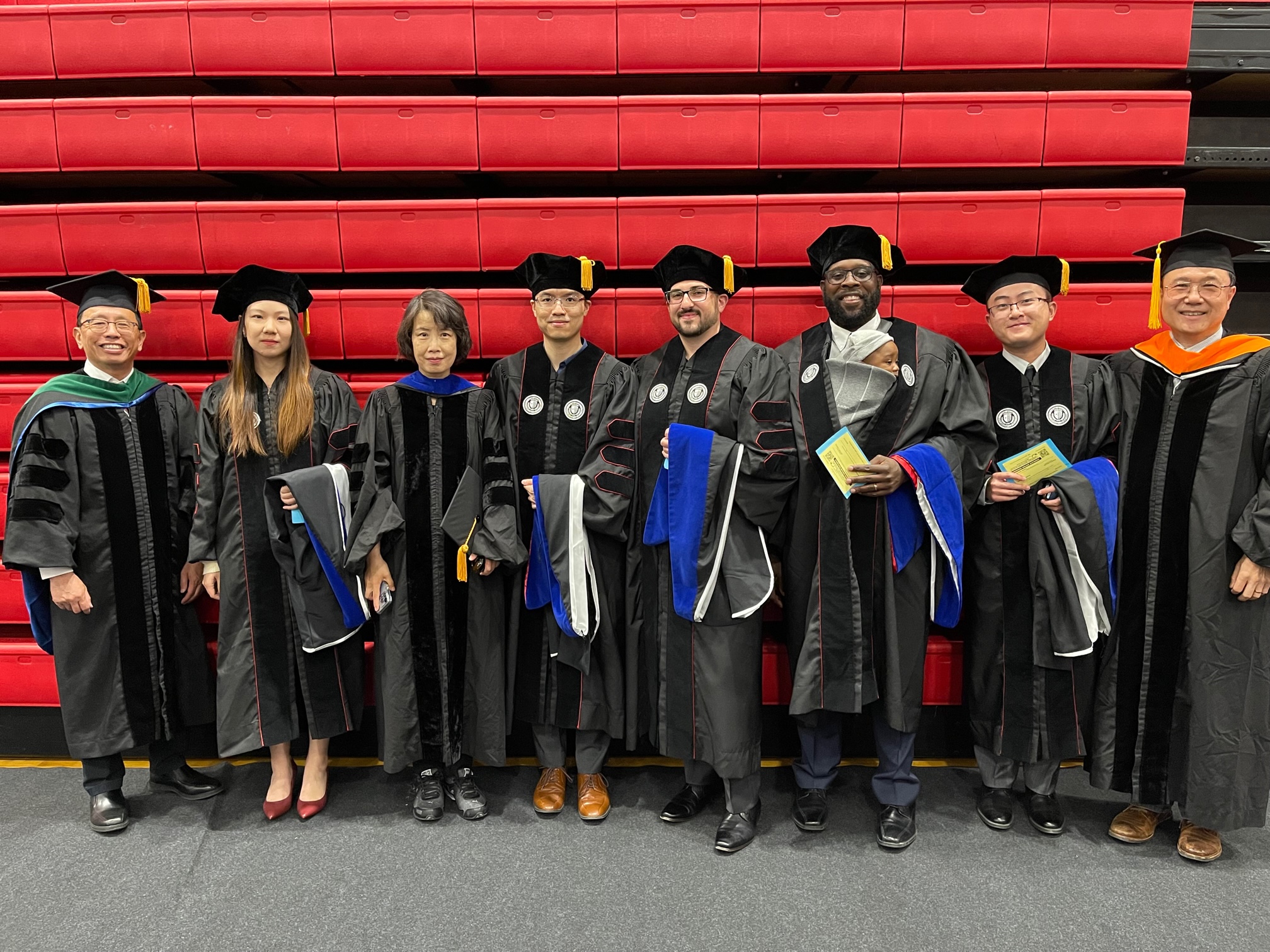
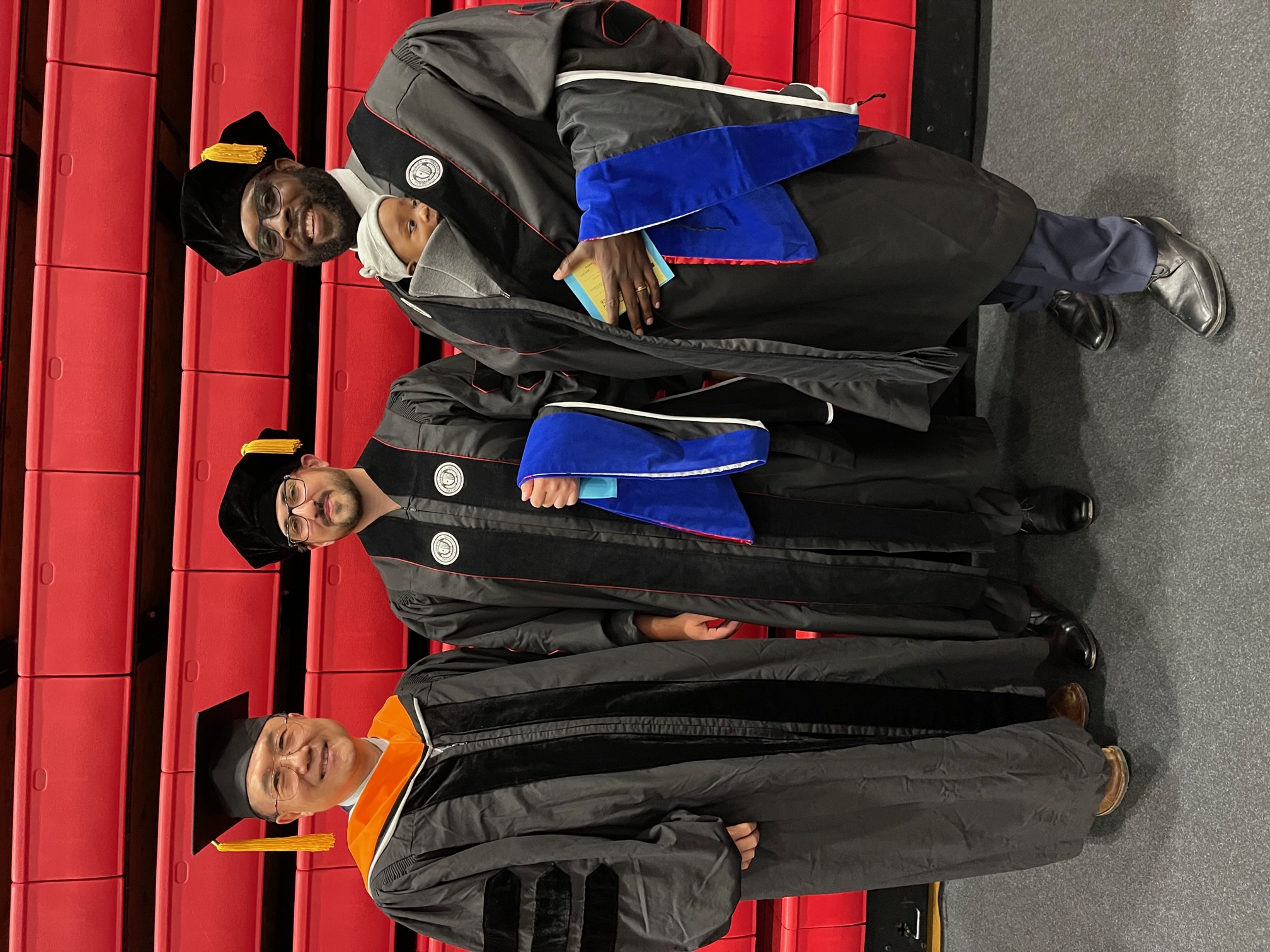
Graduate Program Highlights:
President's Award to Doctoral Students Winner: Yiming Wang (Balazsi Lab)
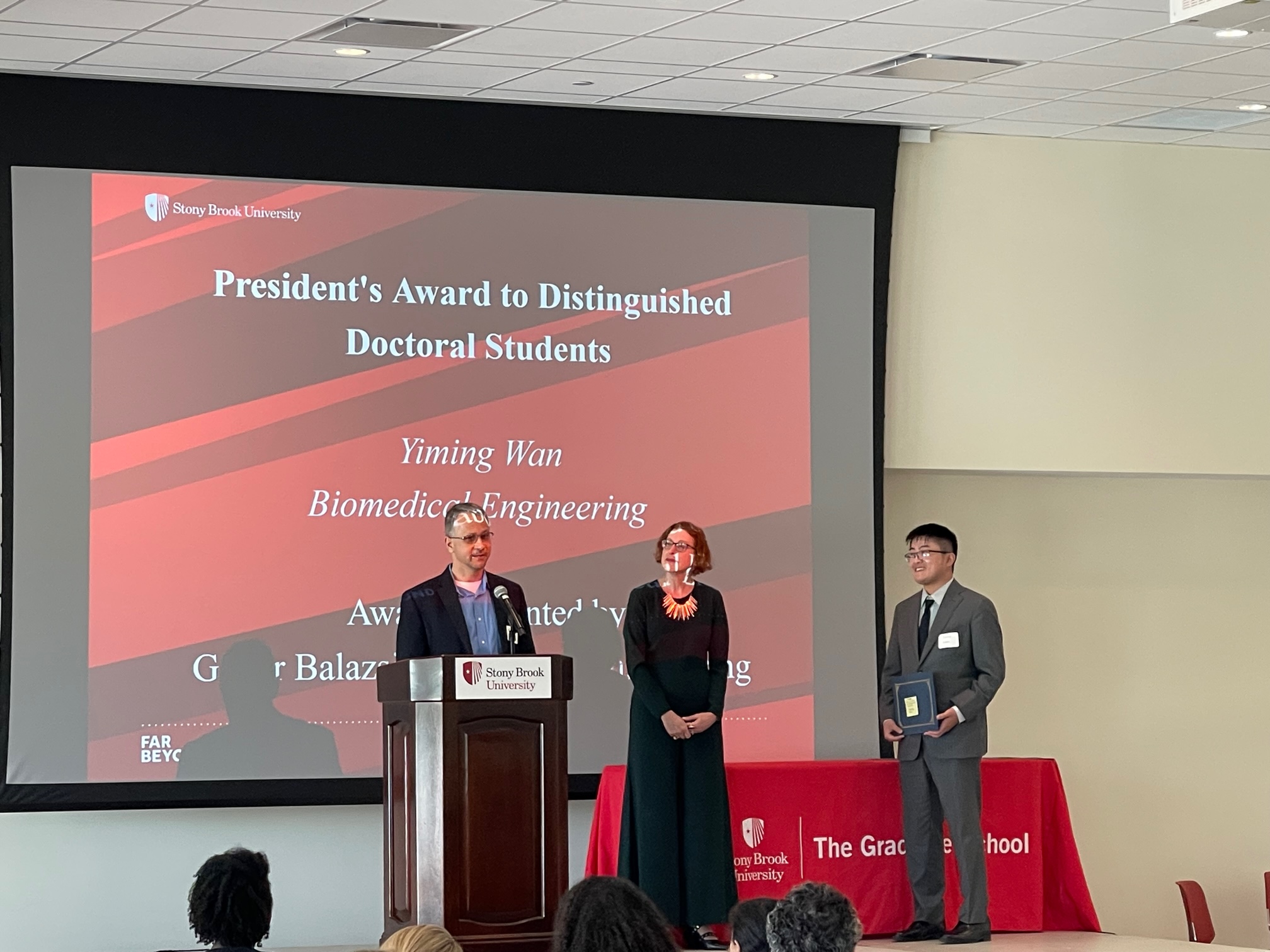
FEBRUARY 2023
Graduate Program Highlights:
2nd Place Awarded IEEE Conference Paper by Zipai Wang
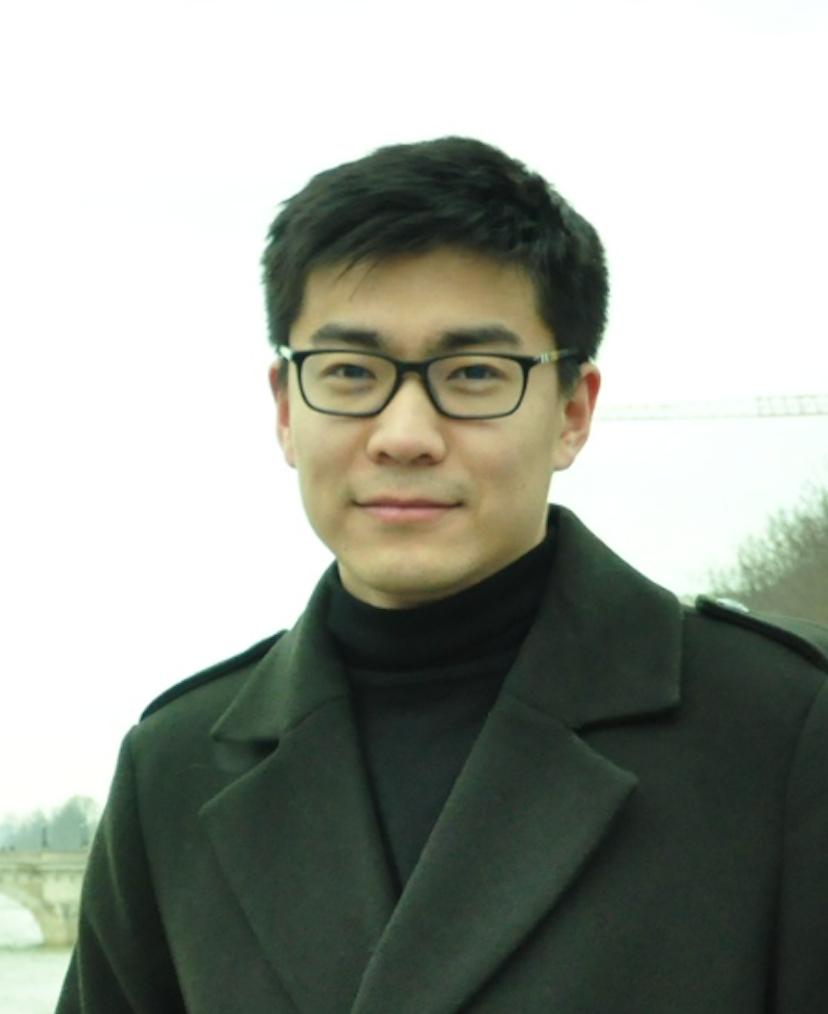
Zipai Wang, a Ph.D. student in the Biomedical Engineering graduate program, received
the 2nd place Christopher J. Thompson Best Student Paper Award for his paper "TOF-DOI
Prism-PET brain scanner: first experimental phantom study of ultra-high resolution
quantitative PET neuroimaging." This was awarded at the 2022 IEEE Medical Imaging
Conference at Milano Italy in November 2022.
In his oral presentation during the conference, he presented the prototype Prism-PET
brain scanner which can overcome the trade-offs among sensitivity, resolution, and
cost. The scanner employs TOF-DOI capable single-ended Prism-PET detector blocks with
a compact and conformal decagon geometry to simultaneously achieve ultra-high resolution
and high sensitivity. The scanner enables quantitative imaging of small but important
brain structures and the full-scale scanner with 12 detector rings will be a promising
cost-effective PET system that can offer next-generation of neuroimaging performance.
This project is supervised by Dr. Amir Goldan and supported by an NIH R01 grant.
October 2022
Graduate Program Highlights:
Communications Biology Paper for Yanzuo Liu
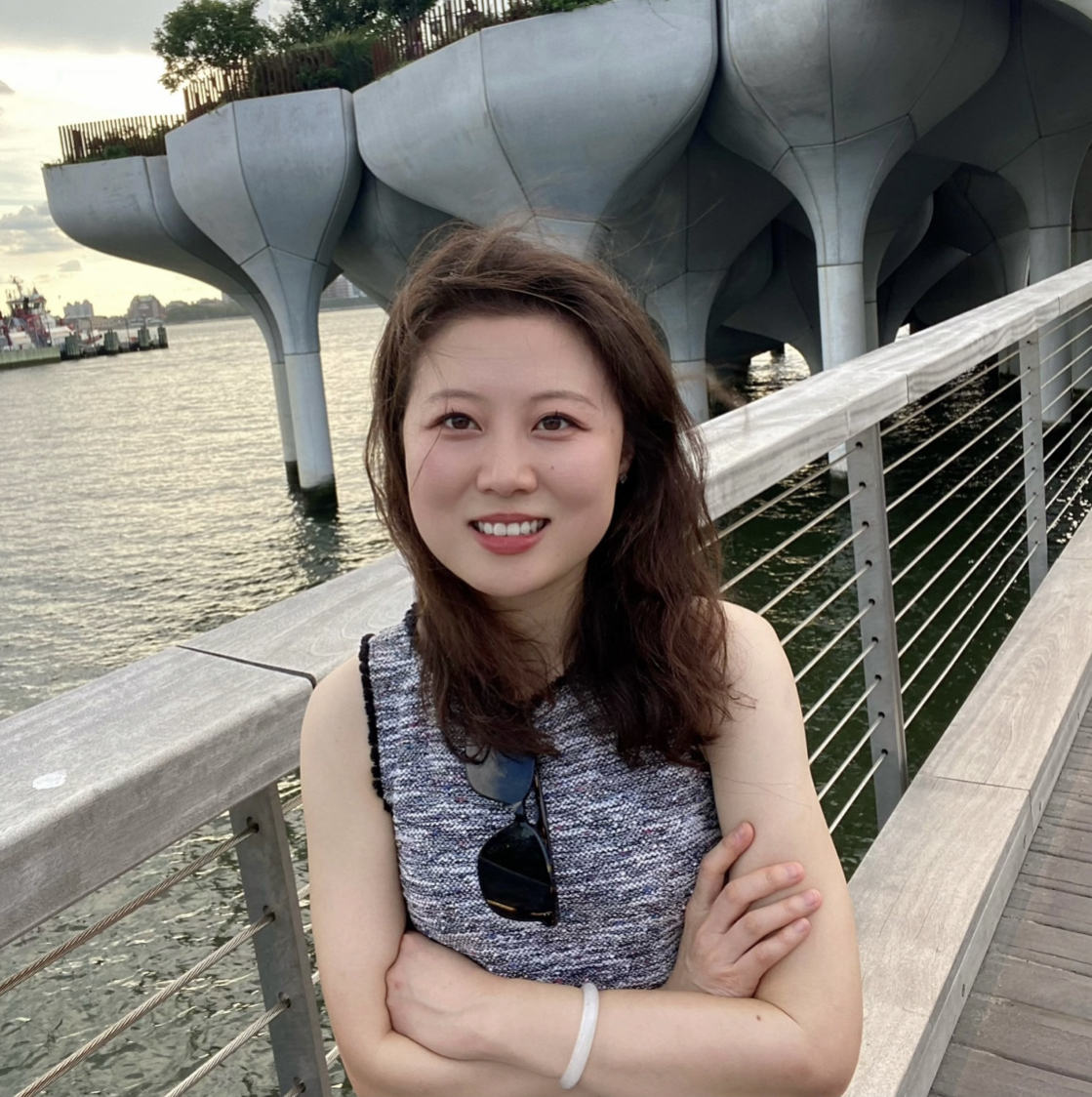 Yanzuo (Zoey) Liu, a Ph.D. student in the Biomedical Engineering graduate program,
recently published an article entitled “Cocaine’s cerebrovascular vasoconstriction
is associated with
Yanzuo (Zoey) Liu, a Ph.D. student in the Biomedical Engineering graduate program,
recently published an article entitled “Cocaine’s cerebrovascular vasoconstriction
is associated with
astrocytic Ca 2+ increase in mice” in the journal Communications Biology (a Nature
publication with an impact factor of 6.3). Her research project emphasized to characterize
the roles of neurons and astrocytes in mediating neurovascular coupling in the brain
while its responses to a stimulant such as cocaine. In this study, it provided first
time evidence of astrocyte’s involvement in the cocaine-induced vasoconstriction.
Her experiments performed by using lab -developed multimodal imaging platform to simultaneously
assess neuronal and astrocytic. activity and vascular hemodynamic changes in response
to acute cocaine in the cortex of mice in vivo. The results showed that cocaine-evoked
neuronal Ca activation inversely correlated with changes in tissue oxygenation, whereas
a long-lasting increase in astrocytic Ca activity were associated with persistent
vasoconstriction induced by cocaine. Also, inhibition of astrocyte activity prevented
cocaine vasoconstriction. These findings indicate cellular and vascular interaction
induced by cocaine which will be helpful for putative treatment strategies to reduce
cerebrovascular pathology in brain diseases including cocaine use disorders.
This research was advised by Dr. Congwu Du in collaboration with Dr. Yingtian Pan
and it was
supported by research grant from NIH. Co-authors including Yueming Hua and Kicheon
Park
both are also graduate students at Stony Brook. For the details of this research,
please check:
 Liu, Y., Hua, Y., Park, K. et al. Cocaine’s cerebrovascular vasoconstriction is associated
with
Liu, Y., Hua, Y., Park, K. et al. Cocaine’s cerebrovascular vasoconstriction is associated
with
astrocytic Ca 2+ increase in mice. Commun Biol 5, 936 (2022). https://doi.org/10.1038/s42003-
022-03877-w
Microsystems and Nanoengineering paper for Evan Lammertse
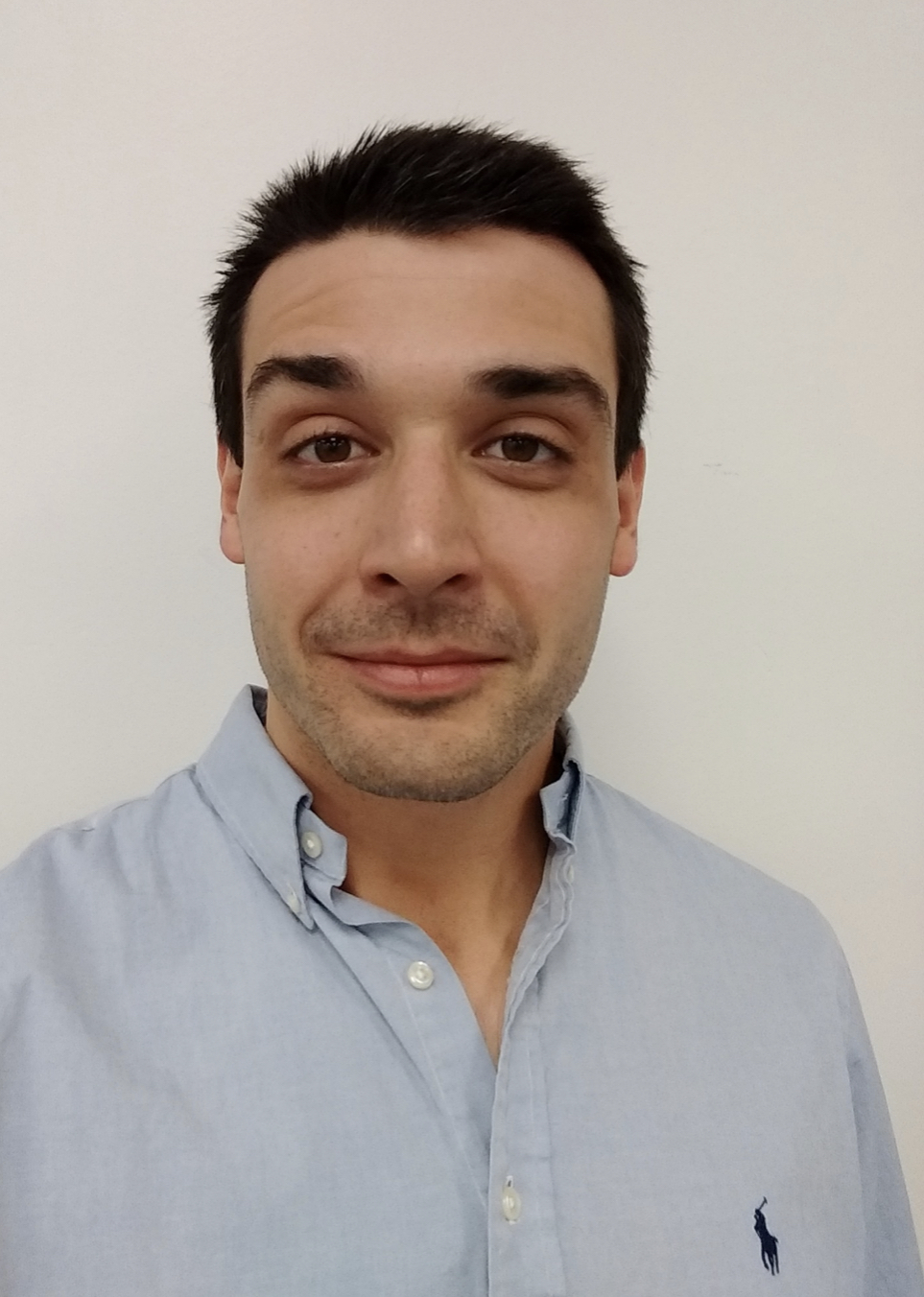 Evan Lammertse, a 4 th year Ph.D. student in the BME graduate program, recently published
an article entitled “Widely accessible method for 3D microflow mapping at high spatial
and temporal resolutions” in the journal Microsystems & Nanoengineering (a Nature
publication with an impact factor of 8). His research demonstrates the ability to
track particles in microfluidic flows in 4D using open source and widely available
equipment. In this report, Evan proved that we could use a simple brightfield microscopy
to perform 3D particle tracing velocimetry to map microflows at high spatial and temporal
resolution. He demonstrated that the 3D tracking of particles could be achieved by
mapping the defocusing pattern to a library of calibrated patterns with a precision
better than one micron. The paper illustrates the method by analyzing flow patterns
of a single-phase flow, displacement structures, and microfluidic droplets. The method
will prove fundamental in supporting the development and design of
Evan Lammertse, a 4 th year Ph.D. student in the BME graduate program, recently published
an article entitled “Widely accessible method for 3D microflow mapping at high spatial
and temporal resolutions” in the journal Microsystems & Nanoengineering (a Nature
publication with an impact factor of 8). His research demonstrates the ability to
track particles in microfluidic flows in 4D using open source and widely available
equipment. In this report, Evan proved that we could use a simple brightfield microscopy
to perform 3D particle tracing velocimetry to map microflows at high spatial and temporal
resolution. He demonstrated that the 3D tracking of particles could be achieved by
mapping the defocusing pattern to a library of calibrated patterns with a precision
better than one micron. The paper illustrates the method by analyzing flow patterns
of a single-phase flow, displacement structures, and microfluidic droplets. The method
will prove fundamental in supporting the development and design of
novel microfluidic structures, and in addressing the increasing demand for controlling
fluids at the micron scale.
The research was performed under the supervision of Dr. Brouzes. Co-authors include
Dr. Martin Sauzade and Luc Anis who are a former post-doc and a BME undergraduate,
respectively. The study was funded by the National Science Foundation.
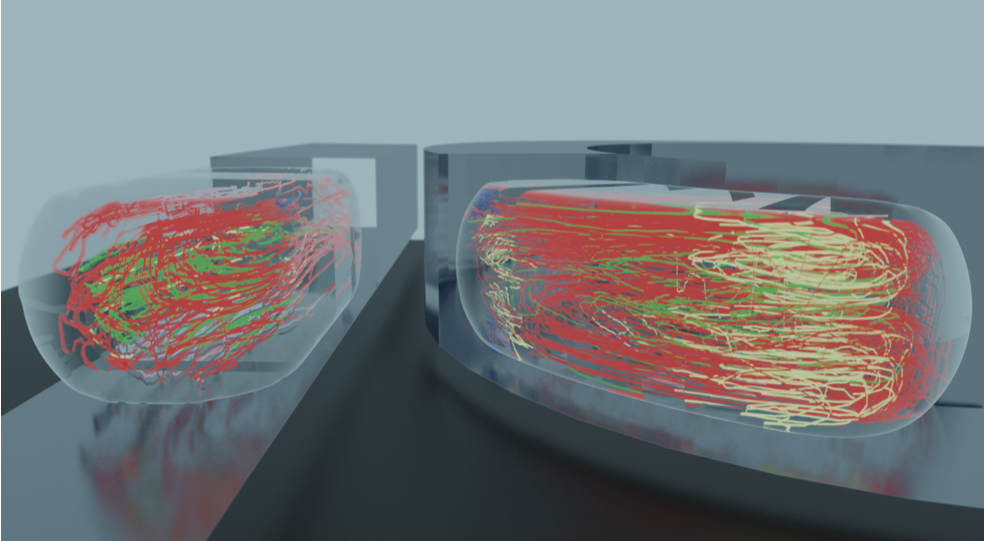
Lammertse, E., Koditala, N., Sauzade, M. et al. Widely accessible method for 3D microflow
mapping at high spatial and temporal resolutions. Microsyst Nanoeng 8, 72 (2022).
https://doi.org/10.1038/s41378-
022-00404-z
September 2022
Snyders Scholars Program Recipient: Christopher Ashdown
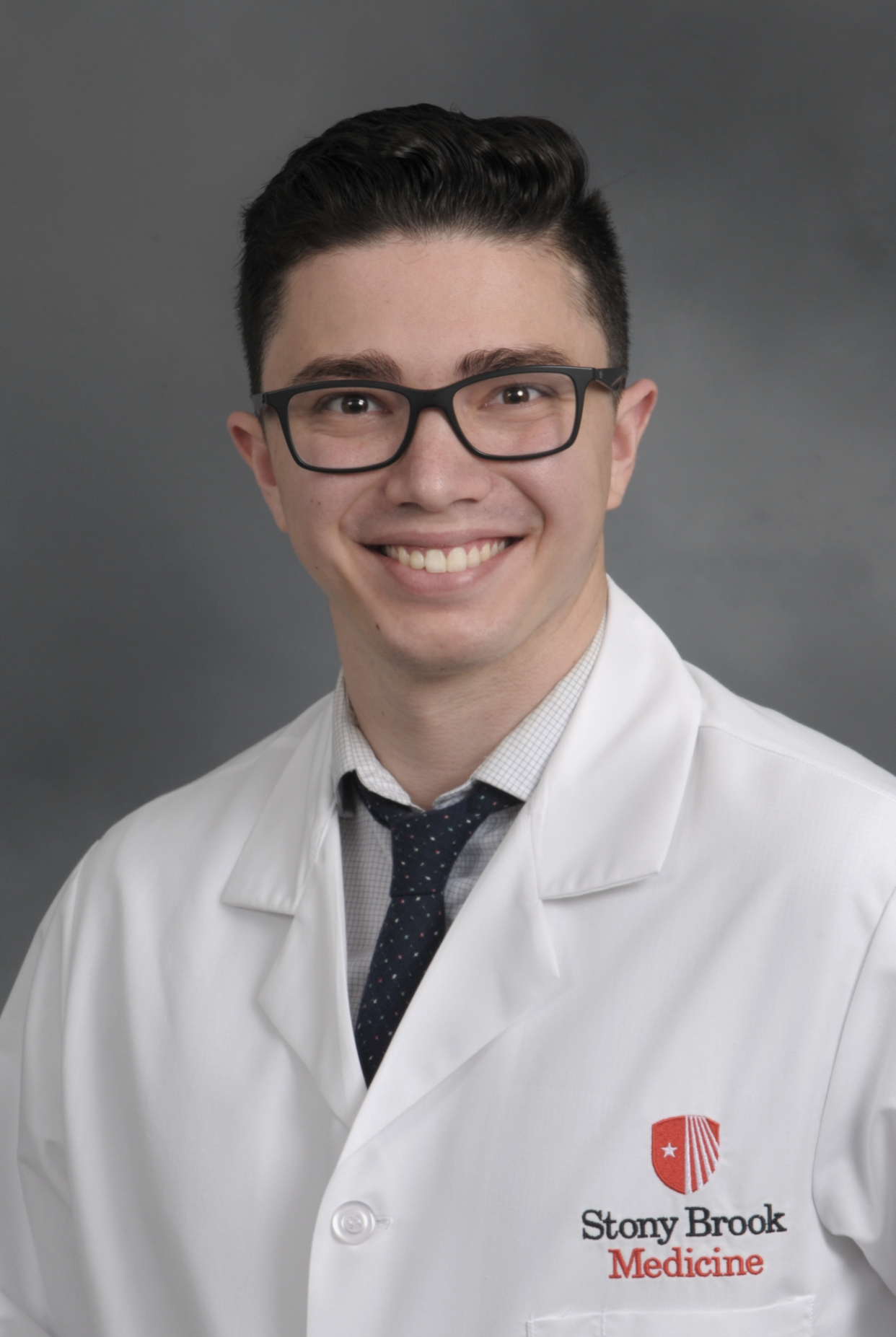 Chimeric antigen receptor T cell therapy, also known as CAR-T therapy, is a rapidly
evolving immunotherapy that has the potential to revolutionize cancer treatment. Nevertheless,
autologous CAR-T therapy remains a relatively inefficient process that is confounded
by prohibitively long ex-vivo expansion periods and loss of effector function upon
reintroduction to the patient. Thus, strategies which speed up the manufacturing process
and help maintain T cell effector function would dramatically increase the speed and
efficacy of CAR-T therapy.
Chimeric antigen receptor T cell therapy, also known as CAR-T therapy, is a rapidly
evolving immunotherapy that has the potential to revolutionize cancer treatment. Nevertheless,
autologous CAR-T therapy remains a relatively inefficient process that is confounded
by prohibitively long ex-vivo expansion periods and loss of effector function upon
reintroduction to the patient. Thus, strategies which speed up the manufacturing process
and help maintain T cell effector function would dramatically increase the speed and
efficacy of CAR-T therapy.
Mammalian cells have well-conserved mechano-sensing and mechanoresponse mechanisms,
the aggregate of which provide an important regulatory component for a variety of
cellular responses. Our lab has spent decades developing Low-Intensity Vibration (LIV)
as a mechanical regime modeled after the physiologic, high-frequency muscle contractions
generated during exercise. We have previously found that in Mesenchymal Stem Cells
(MSCs) LIV promotes both proliferation and differentiation. Our lab and others have
identified that
LIV acts on MSCs through conserved cytoskeletal components (focal adhesions and LINC
complex proteins) as well as through nearly ubiquitous cell signaling pathways (AKT-GSK3b
pathway). In T cells, the AKT-GSK3b pathway plays a particularly important role as
it is involved in CC28 co-stimulation and subsequent activation of the T cell. My
preliminary results have shown that T cells are in fact mechanosensitive to vibration.
I have demonstrated that LIV applied to in-vitro culture can increase T cell number
by 30% over 5 days and alter the expression of activation-associated surface receptors
such as CD62L, CD69, and PD-1. Some of our most recent work indicates that LIV may
indeed by acting on the AKT-GSK3b pathway, as inhibition of this pathway eliminated
the majority of vibration induced changes in T cell proliferation and activation.
Ultimately, funding from the Synder Scholars Program that supports this research will
help further our understanding of cell mechanosensitivity, potentially helping to
generate a non-invasive and non-pharmacologic method for enhancing both the proliferation
and activation of T cells, leading to more effective manufacturing of CAR-T therapy.
August 2022
2022 BME Graduate Program Research Day
After a long hiatus due to the COVID pandemic, the graduate program went back to his roots with an in-person research day that demonstrated the creativity and scientific rigors for our graduate students. The event included both oral and poster presentations and was followed by our not least traditional BBQ.
Students and faculties voted for their favorite presentations:
Students’ choice for the best oral presentation: Evan Lammertse
Development of Magnetized Balls of Acrylamide Gel (MAG-BAGs) for streamlined genomic workflows
Microfluidics for Quantitative and Genomic Biology, PI: Dr. Brouzes

Students’ choice for the best poster: Sai Sreenivasamurthy
Developing woven bone organoids as a therapy platform for bone regeneration
Zhu Lab, PI: Dr. Zhu
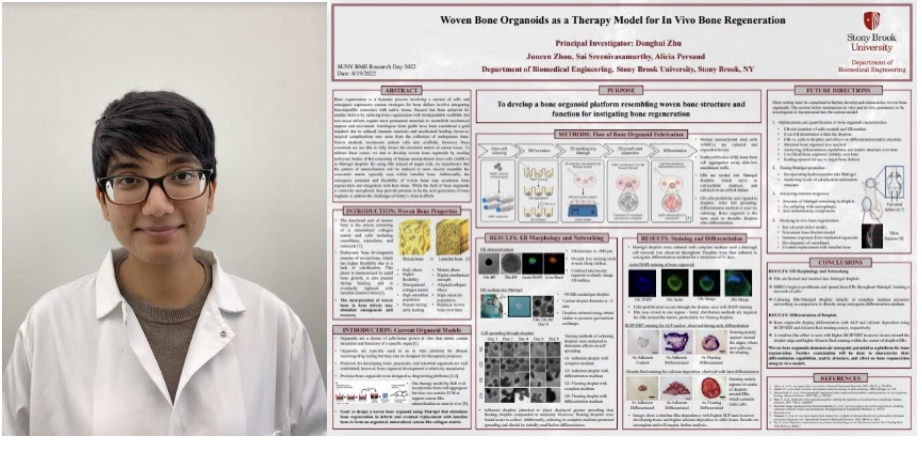
Faculties’ choice for the best oral presentation: Hailing Huang and Peineng Wang
Hailing Huang: Spectral simulation for a dual-layer detector for dual-energy contrast-enhanced breast imaging
Digital Radiological Imaging Laboratory, PI: Dr. Zhao
Peineng Wang: AI-Accelerated Multiscale Modeling For Platelet Adhesion Dynamics And Thrombus Formation At Millisecond and Molecular Resolutions
Biofluids Research Group, PI: Dr. Bluestein

Faculties’ choice for the best poster: Joshua Azukas
Expression Dynamics Utilizing Low-Noise Optogenetic Circuits and Modified Cell Culture Substrates
Micro- and Nano-Technologies for Quantitative Biology Quantitative Analysis of Single-Cell Protein, PI: Dr. Strey
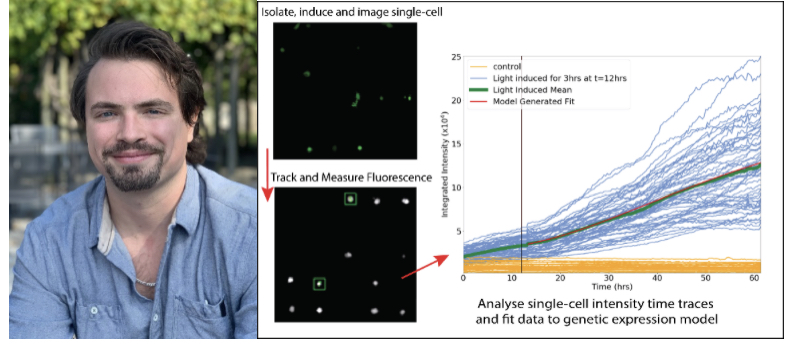
Febrruary 2022
In Memoriam Shmuel Einav, 1942-2022
A pillar of the biomedical engineering community and the field of biofluids and cardiovascular
engineering- Prof. Shmuel Einav, passed away in Israel on February 20, 2022. Besides
his major contributions to our field, Prof. Einav was an inspiring and beloved figure
who was appreciated by many in the bioengineering community. During its nascent years,
he was a part of a small group of visionary academics who helped establish biomedical
engineering as an independent academic discipline and a prosperous research field.
He received his B.S. in mechanical engineering in 1964 and M.S. in nuclear engineering
in 1968 from the Technion, Israel Institute of Technology, followed by a Ph.D. in
mechanical engineering in 1972 from Stony Brook University. At that time he developed
his lifelong interest in the emerging field of bioengineering and pursued a postdoc
in Physiology and Medicine at Boston University. Returning to Israel he became a faculty
at Tel Aviv University (TAU) and rose through the academic ranks, while collaborating
with leading researchers in the US and Europe. He led the process of granting advanced
degrees in biomedical engineering and was the founding chair of the biomedical engineering
department (1993). He then led other BME departments in Israel to offer undergraduate
studies in Biomedical Engineering. Driven by boundless curiosity and always looking
for innovative research directions, his research has led to new insights into the
way we diagnose and treat cardiovascular diseases and develop cardiovascular devices.
He was among the first to investigate and publish in 1975 on LDA measurements of the
flow of red blood cells in the living body. His studies focused on the role of hemodynamics
in the initiation of atherosclerosis, the dynamics of cardiovascular flows and the
associated shear stress on vascular endothelial biology. Prof. Einav also served as
a visiting professor at Boston University, Berkley, Caltech, and MIT. He was a fellow
of ASME, BMES, AIMBE, ICMBE, member of several international academies, and past President
of the Israeli Society for Medical and Biological Engineering. Prof. Einav was the
driving force of the International Biofluid Symposium and Workshop and led and chaired
its conferences from 2003 on. He returned in 2004 to his alma mater Stony Brook University
where he served in leading roles until his retirement last year. Prof. Einav was an
inspirational figure who saw himself as a mentor for young talent and facilitator
of new ideas. He was a researcher, teacher, leader, mentor, and friend to many in
the biomedical engineering community. He will be deeply missed.
The full article of JBME in Memoriam honoring Shmuel Einav's lifelong contribution
can be
viewed via this link:
https://asmedigitalcollection.asme.org/biomechanical/article/144/8/080101/1141608/In-
Memoriam-Shmuel-Einav-1942-2022
January 2022
Alumni Spotlight: Philip Xie publication in Lab on a Chip entitled "Non-contact ultrasound oocyte denudation"
Philip is currently working in Weill Cornell Medicine in New York City as an academic staff as well as an embryologist. His work involves routine clinical andrology and embryology tasks in IVF laboratories as well as research projects involving artificial gametes, developmental biology, as well as designing and testing microfluidic devices to improve and revolutionize IVF lab workflow.
He worked on a team to develop a surface acoustic wave (SAW)-based microfluidic device to successfully achieve oocyte denudation with high efficiency and safety. Compared to the conventional denudation method currently used in IVF clinics, this novel automated device successfully minimized mechanical, thermal, and chemical stress with its safety proven by the generation of healthy mouse offspring. https://pubs.rsc.org/en/content/articlelanding/2022/lc/d1lc00715g/unauth
FEBRUARY 2021
Dr. Mujica-Parodi named a Fulbright Distinguished Scholar Award (2021-2022)
The Fulbright Distinguished Chair Awards comprise approximately forty distinguished lecturing, distinguished research and distinguished lecturing/research awards ranging from three to 12 months. Fulbright Distinguished Chair Awards are viewed as among the most prestigious appointments in the U.S. Fulbright Scholar Program. Candidates should be eminent scholars and have a significant publication and teaching record (definition from Wikipedia). Dr. Mujica-Parodi will be studying at the Department Physics of Complex Systems, Weizmann Institute of Science in Rohovot Israel.
JANUARY 2021
Sindhuja Tirumalai Govindaraj's, BME Graduate Student, Research Showcased on the Cover of Brain Sciences
Multiple sclerosis (MS) is a neurodegenerative disease that causes lesion formation and tissue loss or atrophy in the brain. Cognitive and motor challenges are commonly observed in people with MS. Reduced speed of information processing is typically the first sign of cognitive involvement, which in turn broadly affects other cognitive processes including attention, executive function, and memory. The Attention Network Test—Interactions can measure the efficiency of 3 distinct attentional processes—alerting, orienting, and executive control. In this study, we measured attentional efficiencies and gray matter morphometry in a sample of young adults (18–35 years) with relatively mild MS severity. We show that thickness and volume changes in specific gray matter regions correlate with attentional efficiency even in the absence of widespread atrophy.
The paper can be viewed here.
The cover can be viewed here.
NOVEMBER 2020
Dr. Danny Bluestein awarded the 2021 ASME Savio Woo Translational Biomechanics Medal
Dr. Bluestein has been named the 2021 recipient of the 2021 ASME Savio Woo Translational Biomechanics Medal for his seminal work on thrombosis that represents a paradigm shift in translating biomechanics research to clinical applications, and for meritorious cardiovascular disease studies and thromboresistance optimization in circulatory support devices. The formal presentation of the award will take place during the Summer Biomechanics, Bioengineering, and Biotransport Conference in June, 2021.
OCTOBER 2020
LILAC Enables BME Faculty to Purchase New Equipment
The laboratories of Dr. Brouzes from BME and Dr. Ju from Pathology) received funds from LILAC (Long Island League to Abolish Cancer) to purchase a piece of small thermocycler. We recently received the flat thermocycler that will enable us to perform molecular reactions in flat microfluidic devices. This piece of equipment will be critical to pursue our cancer research projects, particularly for the development of our novel platform for spatial genomics. We are deeply grateful for the generosity of LILAC members and very proud to have LILAC as our partner in our cancer research efforts.
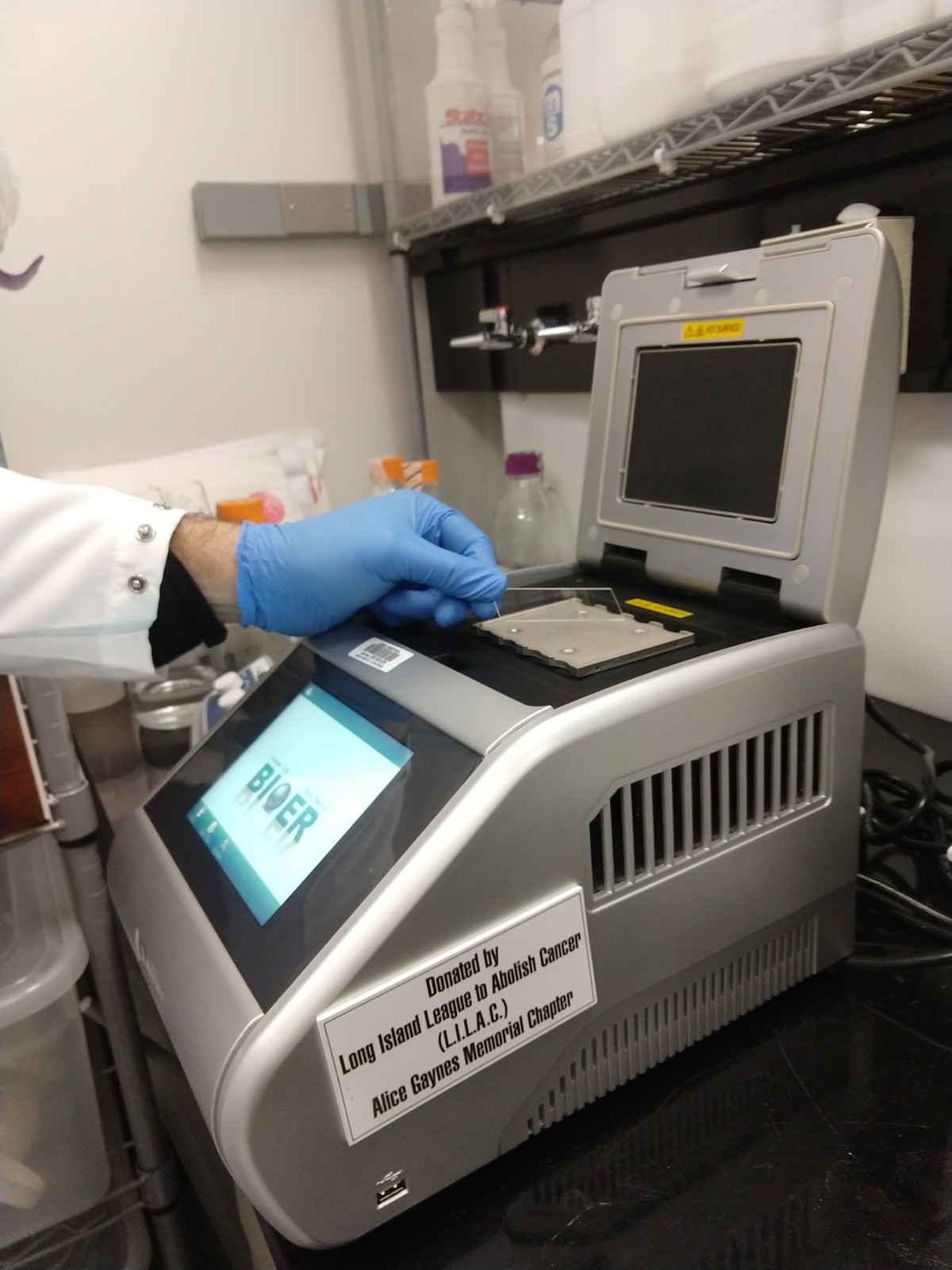
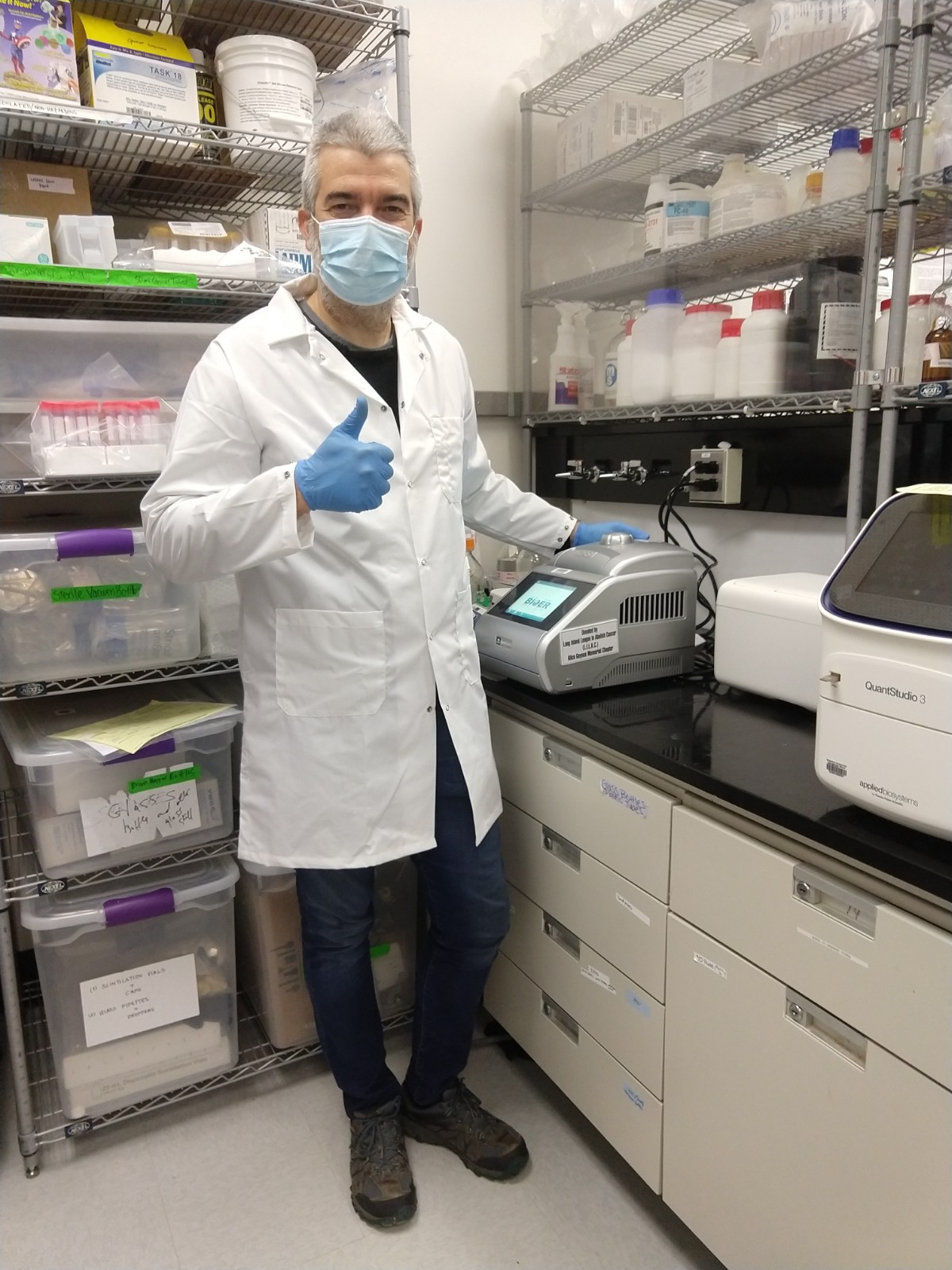
NOVEMBER 2019
BME Undergraduate Design Team Wins 1st Place
Congratulations to Nicole Hershkowitz, Sishir Pasumarthy, Alonzo Tabada, Vincent Destefano,
Yosman Dhar for winning the 1st place award in the Wolfie Tank competition. The team
received a $2000 cash prize and free consultation with a patent attorney. They developed
a prototype for a novel clinical retractor for brain surgery during their Bioinnovation
Summer Internship Program and continued the development of this innovation into their
senior design project.
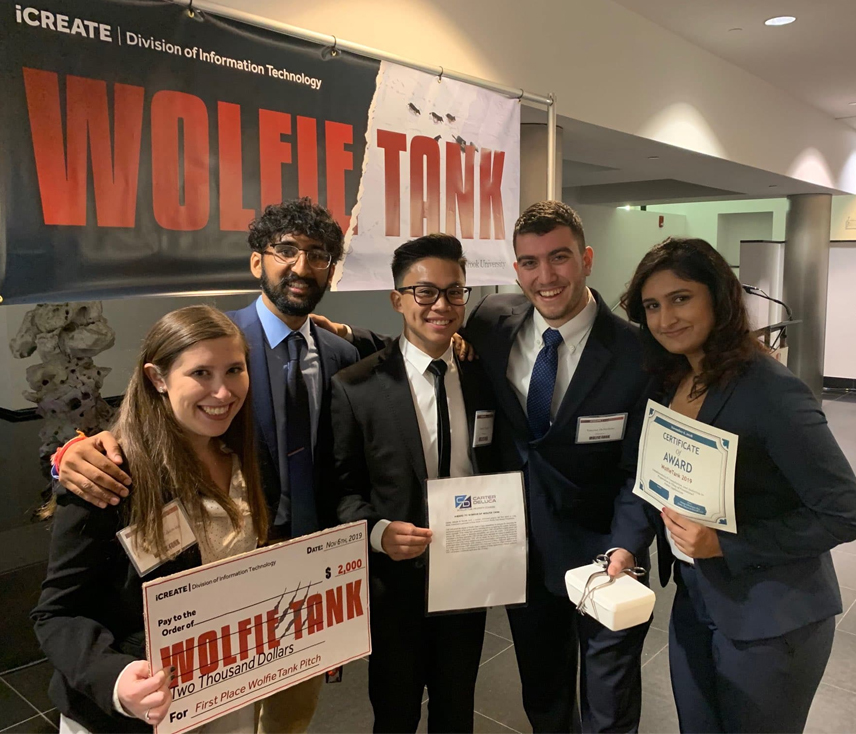
JUNE 2019
Andrew Labella, BME Graduate Student, Lands ACS Photonics Cover
Picosecond timing in an avalanche amorphous selenium semiconductor is achieved by implementing Nano-Frisch grids along the collecting electrode to form a multiwell structure. The induced photocurrent following optical impulse exposure is independent of carrier motion outside the wells resulting in unipolar time-differential charge sensing via extended-state hot hole transport. This is the first experimental report of avalanche gain and picosecond time-resolution using an amorphous semiconductor. Further analysis suggests we may be able to achieve sub-100 picosecond coincidence timing resolution in time-of-flight PET using our multiwell selenium semiconductor as the photodetector. For the Goldan Lab click here or ACS Publications click here.
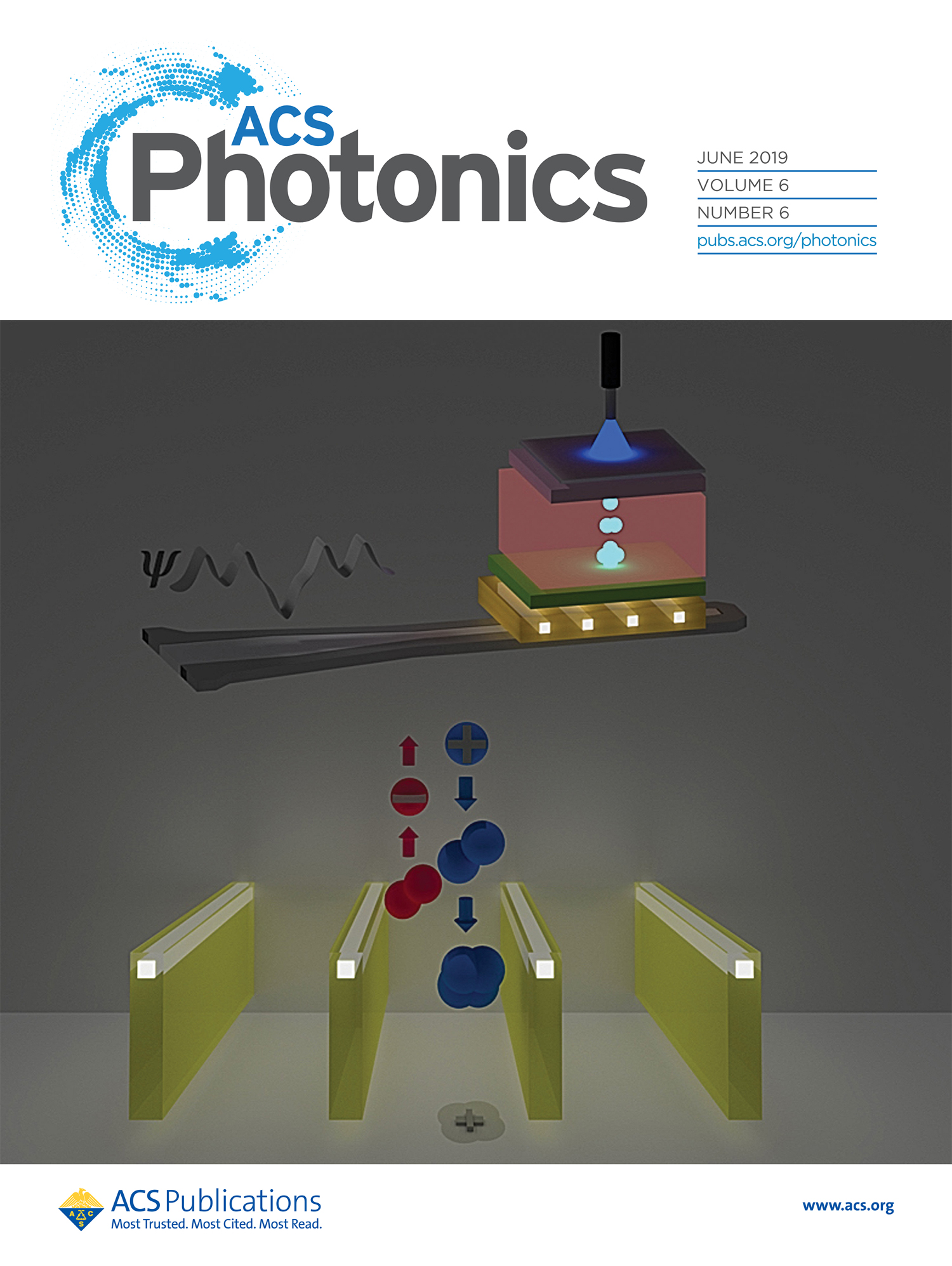
MAY 2019
Dr. David A. Rubenstein, Awarded the 2019 Faculty Award for Excellence
The Center for Inclusive Education at Stony Brook University, awarded Dr. David A. Rubenstein, Associate Professor and Director of the Graduate Program in Biomedical Engineering, the 2019 Faculty Award for Excellence. The citation for this award reads: "In recognition of your commitment to diversity and outstanding contribution to mentoring at Stony Brook University." Congratulations to Dr. Rubenstein!
MARCH 2019
Graduate Students from Dr. Arbab's Lab Win Best Student Paper Award at OTST
Omar B. Osman and Andrew Chen from the Terahertz (THz) Biophotonics Laboratory, won a best student poster award at the eighth international conference on Optical Terahertz Science and Technologies (OTST) in Santa Fe, New Mexico. Omar and Andrew presented their work, titled A THz-TDS study of dehydration dynamics of corneal phantoms, where they report the simulation and validation of the water content of a corneal phantom using THz-TDS. Their poster was selected from approximately 100 poster presentations. This was the first step in the progression towards developing a non-invasive corneal imaging tool using THz imaging. Congratulations to Omar and Andrew!
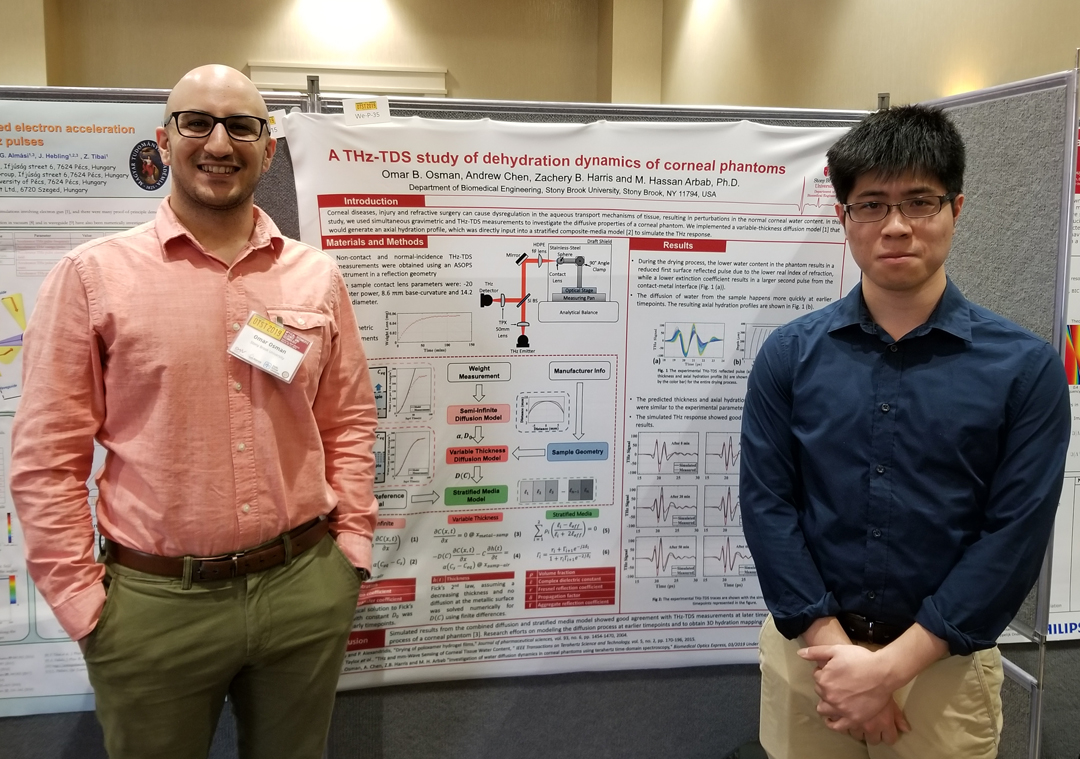
JANUARY 2019
Journal Article by Dr. Bluestein, Ram Ghosh (Doctoral Candidate), Gil Marom (Post-doctoral Fellow) and Oren Rotman (Post-doctoral Fellow) Named as a JBME Editors' Choice for 2018
A recent publication from Dr. Bluestein's Biofluids Research Group, Comparative fluid-structure interaction analysis of polymeric transcatheter and surgical aortic valves' hemodynamics and structural mechanics” published as JBME 140(12):121002, has been named as one of 12 JBME Editors' Choice papers for 2018. These selected papers represent those that the editorial board felt best exemplified the high quality and significance of work in JBME. Click here to view a youtube animation of the work represented in this manuscript. This video was also featured on the ANSYS blog.
OCTOBER 15, 2017
SBU Chapter of AEMB Awarded 2 National awards
The SBU Chapter of AEMB was awarded the "Best Community Service" and "Outstanding Chapter Advisor" Awards at the recent Annual Meeting of the Biomedical Engineering Society. Congratulations on the amazing work from the SBU Chapter.
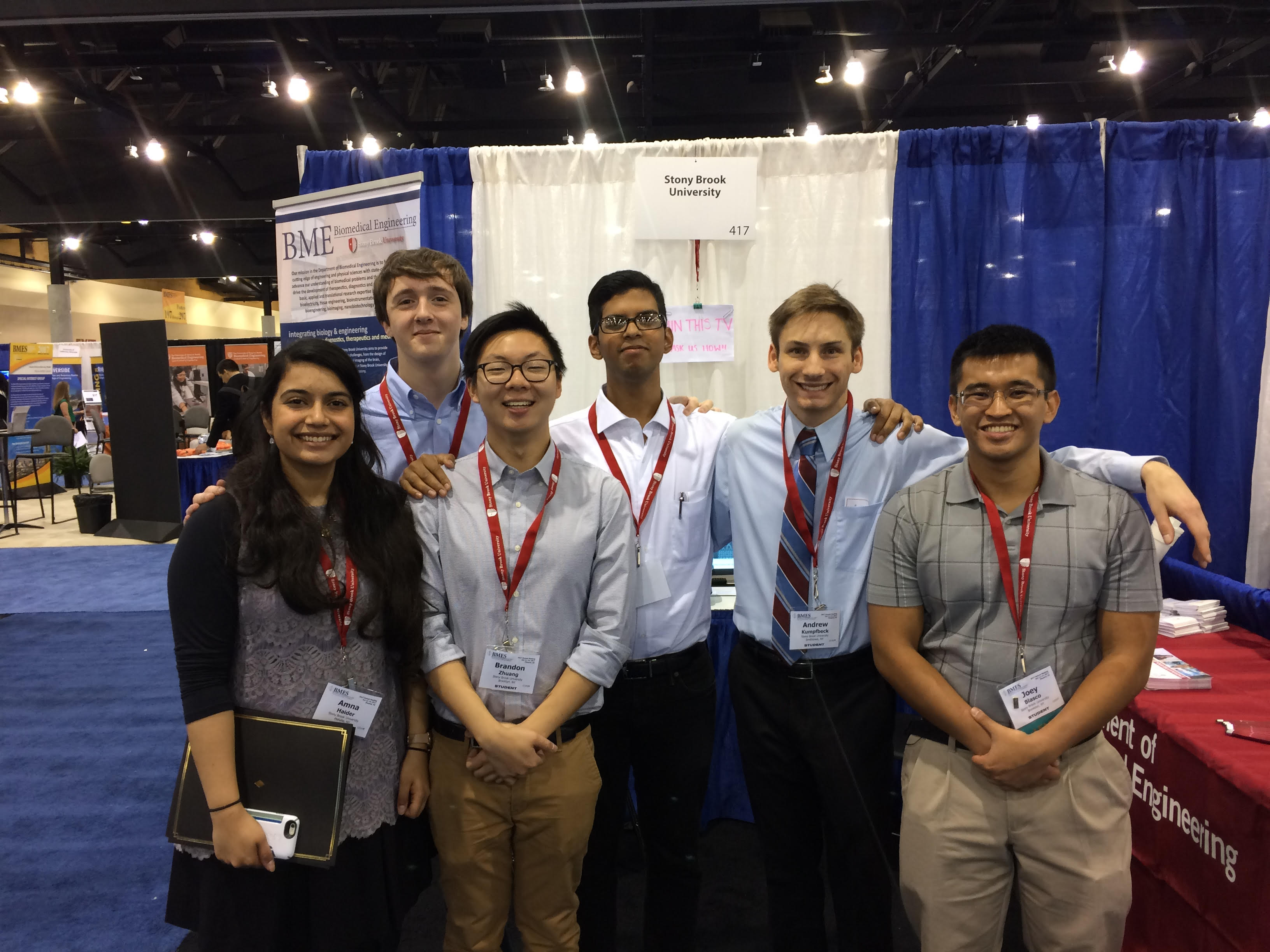
October 14, 2017
TV Winner at the Annual BMES Conference
Congratulations to Nathan Ankomah-Mensah from the University of Rhode Island for winning our TV at the Annual BMES Conference.
OCTOBER 1, 2017
New Leadership Roles in Biomedical Engineering
On October 1, Dr. Clinton T. Rubin, Distinguished Professor and Founding Chair of Biomedical Engineering and Director of the Center for Biotechnology, rejoined the faculty to focus on research endeavors and the promotion of biotechnology and multiple levels. Dr. Stefan Judex, Professor of Biomedical Engineering, has been named as the interim chair. We want to take this opportunity to thank Dr. Rubin for all of his effort in forming the "BME Universe" at Stony Brook University and congratulate Dr. Judex on his new role for the BME department. More information about the new leadership roles can be found here.
August 25, 2017
Vihita Patel, BME Graduate Student, Publishes Findings in Obesity
Vihita is the first author on a publication that used an adult murine model of high fat diet induced obesity. This manuscript shows that obesity leads to adipose tissue dysfunction (increased visceral adiposity, adipocyte hypertrophy, chronic inflammation in adipose tissue, and reduced mesenchymal stem cell population in the adipose tissue) and consequently impaired glucose metabolism (increased glucose intolerance and insulin resistance). Subjecting these obese mice to a very low magnitude and high frequency mechanical stimulation (LMMS) for 6 weeks mitigates obesity-induced adipose tissue dysfunction and impaired glucose metabolism. However, LMMS is more effective when it is delivered in two bouts of 15 minutes per day separated by a 5 hour rest period, rather than one bout of 30 minutes per day. This study provides an insight into how exercise could be beneficial in obesity, emphasizing that with aging, the scheduling of the physical activity is at least as important, if not more, than the activity itself. It also demonstrates that LMMS, as a surrogate to exercise, can serve as a non-invasive and non-pharmacological treatment for obesity without requiring strenuous physical exertion. The entire article can be found here.
AUGUST 23, 2017
3 BME Faculty are Awarded Seed Funding for Cancer Research
2 teams partially composed of BME faculty members, Eric Brouzes, David A. Rubenstein and Helmut Strey are awarded funding for novel cancer research projects. This funding comes as part of the exciting Engineering Driven Medicine colloboration of the College of Engineering and Applied Sciences and the School of Medicine.
August 7, 2017
Nicholas Van Nest, BME Senior, Presents His Summer Research at Washington State University
Nicholas Van Nest presents his summer research conducted with the Center for Bioplastics and Biocomposites at the Washington State University Summer Research Symposium. His research involved the development of a bio-based synthesis pathway for a polymer adhesive, as an alternative to fossil fuel feedstocks. Congratulations.
August 7, 2017
Cerebrovascular adaptations to cocaine-induced transient ischemic attacks in the rodent brain" is published in JCI insight
Occurrence of transient ischemic attacks (TIA) and cerebral strokes is a recognized risk associated with cocaine abuse. Our research, for the first time, bridges the clinical observed cocaine induced transient ischemic attack (TIA) with the cerebral vascular disorder (e.g. vasoconstriction) by using cutting-edge optical imaging technology, ultrahigh-resolution optical coherence Doppler tomography developed in our lab. In this study, we reported longitudinal imaging to reveal the process of repeated cocaine induced vasoconstriction, TIA and hemiparalysis, and vasoadaptation including vascular redistribution and neoangiogenesis to partially ameliorate the symptom of TIA and brain damage.
July 26, 2017
Henry Towery, Class of '17, Motivated to Make a Difference
Henry Towery, Biomedical Engineering Alumni of the Class of 2017, is Motivated to making a difference in clincical research.
JUNE 15, 2017
Michael Salerno, BME Graduate Student, Awarded the Chateaubriand Fellow
Congratulations to Michael Salerno, who has been named as a 2017-2018 Chateaubriand Fellow. He will be supported to study PET imaging in France for 9 months.
JUNE 9, 2017
Andrew Kumpfbeck, a BME major (Class of 2018), named URECA Researcher of the Month
Congratulations to Andrew for being named as the URECA researcher of the month. He is currently working with Dr. Prives (Pharmacological Sciences) and Dr. Frame (BME).
JUNE 9, 2017
Eric Brouzes, BME Assistant Professor, Discusses A Recent Publication in Lab on A Chip
Recently, technologies based on droplet microfluidics have enabled the development
of novel platforms to facilitate single-cell analysis, paving the way towards a better
understanding of the role of tissue heterogeneity in the development of diseases such
as cancer. Platforms relying on droplets microfluidics operate at very high-throughput
and are unable to reliably deposit one individual cell per droplet. Both aspects hinder
the development of droplet-based devices for processing samples of limited availability
such as needle biopsies or isolated CTCs.
In this Lab on a Chip communication, we introduce an innovative strategy for the preparation
of precious samples for single-cell analysis. Individual cells from the sample are
captured using hydrodynamic traps before introducing an oil phase which sequentially
surrounds the cell-occupied chambers. This results in the generation of numerous droplets,
each containing a single cell. The encapsulated cells can then be retrieved from the
platform for analysis using established droplet-based technologies. Our device efficiently
encapsulates hundreds of individual cells into droplets while exhibiting no sample
loss, effectively laying the foundations for the single-cell analysis of rare samples
via droplet microfluidics.
MAY 4, 2017
Dr. Clinton Rubin, BME Distinguished Professor and Chair, and Director of Center for Biotechnology, Talks on Improving SBIR and STTR Programs
Dr. Clinton Rubin talks NIH-REACH program as catalyst for tech & econ dev at joint congressional hearing. Start video at 2:53 to hear Dr. Rubin's remarks.
APRIL 10, 2017
Dr. Danny Bluestein, BME Professor, Awarded a New Grant
Congratulations to Danny Bluestein who has received a Phase 1 STTR grant entitled "A novel polymeric valve for transcatheter aorta valve replacement. This is a 2 year grant for a total of $225,000.
APRIL 10, 2017
Dr. Gabor Balazsi, BME Associate Professor, Awarded NIH Grant
Congratulations to Dr. Balazsi and his team for being awarded a 5 year NIH grant entitled "Dynamics and Evolution of Synthetic and Natural Gene Regulatory Networks."
APRIL 4, 2017
Gabor Balazsi, BME Associate Professor, Named as a Discovery Prize Finalist
Stony Brook has earned its stellar reputation as a prestigious research institution
because of its many breakthrough discoveries — such as developing the technology for
the MRI — made during the past several decades. In a time of dwindling federal funding,
it is crucial that we continue to support fundamental research and encourage our greatest
minds to pursue the big ideas that transform lives and make an impact around the world.
With this in mind, we established the Discovery Prize in 2013 with a generous donation
from the Stony Brook Foundation Board of Trustees. The Prize is awarded to an early-career
Stony Brook faculty member in the STEM disciplines whose pioneering project embraces
risk and innovation and embodies the potential of discovery-driven research — the
catalysts for scientific advances.
APRIL 3, 2017
Dr. Qin on Capitol Hill; Advocating for NIH Research Funding
As a delegate for the American Academy of Orthopaedic Surgeons (AAOS), Dr. Qin went to Washington for a Research Capitol Hill Days. Their goal is to encourage Congress and Senate to pass NIH FY 2017 bill ($34.1B) and FY 2018 bill ($36.1B). This is a critical year. The whole team represents total of 24 orthopaedic related societies. The small group includes an orthopaedic surgeon, Dr. Gary Brock, a Victoria Secret supermodel, Martha Hunt, as a patient advocate, and Dr. Qin as a researcher. They visited both NY and TX Congress and Senate Offices, including Chuck Schumer, Lee Zeldin, John Cornyn, Kristen Gillibrand, Nita Lowey, and John Culberson. It was a very busy and productive day, but absolutely worthwhile. Their voices were heard loudly. Their impression is that to keep and/or increase NIH budget, it must be supported in bipartisan at least for these two States. Both Senators and Congressman/Congresswoman are willing to fight for NIH.
JANUARY 23, 2017
Stony Brook Ranked #7 for percent of students from the bottom fifth of the income distribution who end up in the top three-fifths
Stony Brook was recently ranked by the New York Times as one of America's Great Working-Class colleges.
OCTOBER 25, 2016
Shu Jia, BME Assistant Professor, Awarded 2 Prestigious Awards
The National Science Foundation and the Defense Advanced Research Projects Agency has funded two projects focused on the development of new super-resolution light microscope for both imaging of cells, tissues and organ systems and specifically will try to develop an understanding of the brain. Congratulations to Shu and his research team!
SEPTEMBER 27, 2016
Amna Haider, BME Junior, Featured on PSEG LI Investing in the Future of Stem
Congratulations to Amna for her research work this summer, funded by PSEG LI, to look into the role of cocaine on bone mechanical/physical properties. Amna is currently working on the direction of Drs Ete Chan and Clint Rubin. Bruce Coluccio, a BME Sophomore, and Robert Bruce, a Physics Major, also work with Drs Chan and Rubin over the summer in this project. Congratulations to all for their important work.
SEPTEMBER 20, 2016>
Assistant Professor, Shu Jia, has been named as a DARPA Young Faculty Awardee
The awarded project entitled: "Wavefront-Engineered, High-Speed Super-Resolution Microscopy
for Nanometer-Scale, Live-Tissue Imaging" is at the forefront of super resolution
microscopy.
The advancement of our understanding of biology has been greatly reliant on observations
of cells. Light microscopy, especially fluorescence microscopy, has evolved to observe
smaller specimens with greater resolution. The spatial resolution of a microscope
is defined as the smallest distance in an image in which two distinct points can be
distinguished. Because of the diffraction of light, resolution had previously been
thought to have a theoretical limit from what is called Abbe's diffraction limit of
light (~200-300 nanometers). Recent emergence of super-resolution imaging techniques
has surpassed this limit, allowing visualization of cellular and sub-cellular structures
with ~10-20 nanomater resolution at the near-molecular-scale. This advance provides
thriving opportunities for exploring the complex structure, dynamics and function
of biological molecules. Due to the significant impact of these new techniques, the
2014 Nobel Prize in Chemistry was awarded to the development of super-resolution fluorescence
microscopy.
The research in the Jia Laboratory aims to enhance this resolving power across unexplored
regimes in space and time to attain a better understanding of the molecular basis
for the functions of tissues and organisms. To achieve the goal, the group investigates
the physical and engineering principles underlying single-molecule imaging in complex
biological materials, and utilizes these principles to develop new biophotonic methods
for super-resolution microscopy. These methods include optical physics, optical wavefront
engineering, single-molecule biophysics, adaptive optics, phase microscopy, large-data
processing, advanced instrumentation, nano-fabrication, etc.
One super-resolution imaging method currently under investigation is called stochastic
optical reconstruction microscopy (STORM), which relies on imaging of single molecules
to reconstruct fluorescence images with sub-diffraction-limit resolution. In biological
systems, how these single-molecule mechanisms are integrated over larger scales is
critical for understanding physiological functions and disease initiation of complex
biological systems. There remains a great demand in an enabling technology to extract
such single-molecule information and dynamics across large volumes of specimen with
ultra-high spatiotemporal resolution.
The DARPA award will support the lab's development of a new super-resolution microscopy
system for in vivo investigations of cell, tissue and organ functions. The research
will base on the lab's expertise in a technique called point spread function engineering,
which can modify how light is propagated within an imaging system to achieve better
imaging capability. By exploring and implementing a new type of optical non-diffracting
waveforms, the light within a microscope can propagate in a dramatically different
way from normal light. One typical feature is that it will not spread out as much
as described by the usual diffraction effect of light. This allows people to image
further deeper into biological samples. In addition, it also provides better 3D resolution
and is more robust to scattering effect in biological tissues.
First trained as an applied physicist and electrical engineer and later into a bioimaging
expert, Dr. Jia is passionate about advancing imaging technology with new physical
concepts and engineering design. The highly interdisciplinary team consists of experts
from physics, computer science, engineering, and biology. In collaboration with researchers
both within the Department of Biomedical Engineering and elsewhere, the lab expects
their new technologies would provide new insights and solutions to challenges in biological
and ultimately clinical research.
AUGUST 16, 2016
James Scheuermann wins First Place
Congratulations to BME Ph.D. Candidate, James Scheuermann who won first place in the John R. Cameron Young Investigators Competition held by the American Association of Physicists in Medicine.
AUGUST 1, 2016
Ete Chan wins SUNY Funding to Develop a Virtual Lab
Ete Chan, Assistant Professor, has received funding which will explore and develop the creation of virtual labs for Biomedical Engineering students. She is the leader of a group of biomedical engineering faculty and students and computer science faculty and students that will implement this project. Congratulations.
JULY 22, 2016
ASEE TV Highlights CEAS Research and Educational Mission
Dr. Ete Chan and BME Junior Amna Haider were featured on the ASEE Highlights of CEAS Research and Education. Congratulations.

